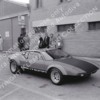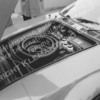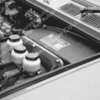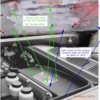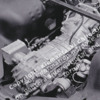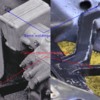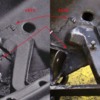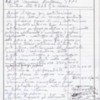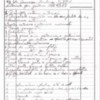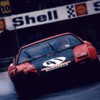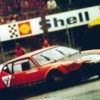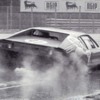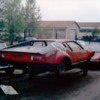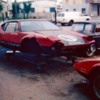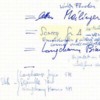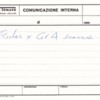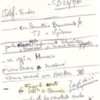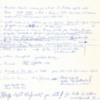Yes. Philippe/Vito/Whatever,we have heard your point.
Now let's see more of this magnificent car which has obviously racing history.
Magnificent car,
Please share more!! It's like an archeological dig site - Awesome, thanks for posting.

Please share more!! It's like an archeological dig site - Awesome, thanks for posting.
Once again Philippe explains that the documents are more important than the car itself .....
Remind me, what does he sell Philippe, documents or cars?
Remind me, what does he sell Philippe, documents or cars?
The Reaper (Guest)
This car "was" a good looking GT5. Marcel Schaub once owned this car. Is he still involved with it or did he sell it?
René
René
Marcel sold us the car.
The Reaper (Guest)
Are you intending to take this chassis back to Group 4 specification?
If so have you acquired all the parts needed to do that authentically? ($$$$)
If so have you acquired all the parts needed to do that authentically? ($$$$)
It has already been restored to its original 1972 Group 4 specs.
Yes I see evidence of a Group 4 car, nothing as yet that leads me to believe it is 2263? How do you come to that conclusion?
Were there any numbers stamped on the underside of the headlight buckets?
Were there any numbers stamped on the underside of the headlight buckets?
The Reaper (Guest)
quote:Originally posted by Rik911:
It has already been restored to its original 1972 Group 4 specs.
Authentic group 4 parts don't grow on trees. I hope as your thread progresses you'll show us those parts as well, not just the chassis.
quote:Originally posted by Joules:
Yes I see evidence of a Group 4 car, nothing as yet that leads me to believe it is 2263? How do you come to that conclusion?
Were there any numbers stamped on the underside of the headlight buckets?
If there were they would be 263 or 63 !!!!
quote:Originally posted by The Reaper:quote:Originally posted by Rik911:
It has already been restored to its original 1972 Group 4 specs.
Authentic group 4 parts don't grow on trees. I hope as your thread progresses you'll show us those parts as well, not just the chassis.
You will see the end result of course. And you are right the original Pantera Group 4 parts are very hard to find.
quote:Originally posted by Denis C:quote:Originally posted by Joules:
Yes I see evidence of a Group 4 car, nothing as yet that leads me to believe it is 2263? How do you come to that conclusion?
Were there any numbers stamped on the underside of the headlight buckets?
If there were they would be 263 or 63 !!!!
The right headlight bucket has been changed after the crash at Monza, and the left one has no number stamped on it.
Third part :
We have never denied that our car, the very first original factory De Tomaso Pantera Group 4 chassis 2263, had been stamped by the factory with a new number 8263 in 1979, when it was converted to a road car for the German importer.
We have kept that chassis number 8263 on the car today, because it is part of the history of the car and it would have been a nonsense to erase it.
That said, it is important to understand that 2263 did not have any chassis number stamped in 1972, but only had two unique riveted chassis plates to identify it.
The Pantera Group 4 had been officially introduced to the press on the 31st of January 1972. The car used for the official presentation was 2263. We have found professional pictures taken that day at the factory.
Please note that all black and white pictures that will follow are owned by the Klemantaski Collection. These pictures cannot be copied nor used by any means. They are here only for information purpose.
We have never denied that our car, the very first original factory De Tomaso Pantera Group 4 chassis 2263, had been stamped by the factory with a new number 8263 in 1979, when it was converted to a road car for the German importer.
We have kept that chassis number 8263 on the car today, because it is part of the history of the car and it would have been a nonsense to erase it.
That said, it is important to understand that 2263 did not have any chassis number stamped in 1972, but only had two unique riveted chassis plates to identify it.
The Pantera Group 4 had been officially introduced to the press on the 31st of January 1972. The car used for the official presentation was 2263. We have found professional pictures taken that day at the factory.
Please note that all black and white pictures that will follow are owned by the Klemantaski Collection. These pictures cannot be copied nor used by any means. They are here only for information purpose.
Attachments
The same picture zoomed.
These two plates are quite unique. First, it is easy to see that in 1972 the car was not fitted with the regular chassis plate of any De Tomaso Pantera. Secondly, there was no chassis number stamped on the footbox where it is usually present on a regular Pantera.
Instead there are a De Tomaso Vallelunga plate (on the left, looking at the picture), and a long plate (on the right, looking at the picture) on which the chassis number was probably stamped.
These two plates are quite unique. First, it is easy to see that in 1972 the car was not fitted with the regular chassis plate of any De Tomaso Pantera. Secondly, there was no chassis number stamped on the footbox where it is usually present on a regular Pantera.
Instead there are a De Tomaso Vallelunga plate (on the left, looking at the picture), and a long plate (on the right, looking at the picture) on which the chassis number was probably stamped.
Attachments
Now fast forward to 1979. 2263 was supposed to be destroyed after the agreement taken with the insurance company, but instead it was stored behind the factory since 1972. So as to build a GT5 road car demonstrator, the factory reused 2263, stamped it with a new number 8263 and put a regular Pantera plate on it.
Here it is, as found in 2016 :
Here it is, as found in 2016 :
Attachments
When we removed the plate, we discovered many holes and even rivets left on the footbox of our car. The following picture compares the period picture of the chassis plates (as published here above) with the footbox of our car found in 2016. There are not only the four holes corresponding to the regular chassis plate fitted in 1979 when the car was stamped with the new number 8263, there are also the holes drilled in 1972 to fit the Vallelunga plate as well as the holes (and rivets) for the long chassis plates where the chassis number was probably stamped.
This shows a strong evidence that our car is nothing else but the original factory Pantera Group 4 2263.
This shows a strong evidence that our car is nothing else but the original factory Pantera Group 4 2263.
Attachments
The weldings and unique reinforcement rear bars.
In the photo set from the January 1972 official presentation of the Group 4, there is a very interesting picture showing the engine compartment. It shows two reinforcement bars that are unique to 2263. They are still in our car today.
What seems like a bullet proof evidence that our car is 2263, is the shape of the weldings done in the engine bay around these bars. The weldings were poorly finished so that they have a random shape. You will see on the comparison picture between 1972 and today that our car still has the exact same weldings, with the same shape in the exact same place as 2263 in 1972.
This again shows a strong evidence that our car is nothing else but the original factory Pantera Group 4 2263.
In the photo set from the January 1972 official presentation of the Group 4, there is a very interesting picture showing the engine compartment. It shows two reinforcement bars that are unique to 2263. They are still in our car today.
What seems like a bullet proof evidence that our car is 2263, is the shape of the weldings done in the engine bay around these bars. The weldings were poorly finished so that they have a random shape. You will see on the comparison picture between 1972 and today that our car still has the exact same weldings, with the same shape in the exact same place as 2263 in 1972.
This again shows a strong evidence that our car is nothing else but the original factory Pantera Group 4 2263.
Attachments
quote:It shows two reinforcement bars that are unique to 2263. They are still in our car today.
Actually, the reinforcementbars are std. to all the Pantera chassis prior til maybe #2700, but I agree the welds are unique and recognizable.
What I find even more convincing are the chassis transaxle mounts - they are not the std mounts but unique fabricated sidemount brackets present both in the 1972 and 2016 pictures.
The sidemounts of the Pantera were introduced on the production Pantera chassis at a later point (I think after 2263) and looked different. Prior to that the Pantera chassis had a single rear mount for the transaxle, and if I'm not mistaken, you can actually see the holes with threads for the rear mount still present in the rear crossmember!
Why, I engage myself for this cause who dont bring anythings to me ?
Who is silent consents.
In a bus, if a mother strikes her child and no one says anything, you are all accomplices to the beatings that the child has received.
Who is silent consents.
In a bus, if a mother strikes her child and no one says anything, you are all accomplices to the beatings that the child has received.
quote:Originally posted by Olczyk:
In a bus, if a mother strikes her child and no one says anything, you are all accomplices to the beatings that the child has received.
And I find that very well, a slap has never hurt a kid. I have received a number of them and I am very well, I have given some to my own children and they are doing very well too, and they are quite grateful to me for that.
But we move away from the subject .....
It's great Philippe, you are a great philanthropist we have all understood for a long time.
weld photos are compelling.... I am a believer.
I think you found your pot of gold. I also believe that it is the original Pantera. I would feel compelled to try to bring it back as a Group 4. Congratulations
Well I'm not quite there yet, where money and vintage race cars are involved there's a lot of underhand stuff that happens. As the car is not as found and has already been restored to Group 4 it's pretty easy to recreate a few blobs of weld...
What documented evidence is there over the anecdotal?
What documented evidence is there over the anecdotal?
Now that we have shown you the physical evidences which show our car is indeed the very first original factory Pantera group 4 chassis 2263, let's dive into the documents. We have 70 pages of period documents or copies of period documents on 2263 and 8263 gathered by the former owner and us. It would be tedious to publish everything here but we will focus on extracts that will show you that the factory did modify 2263 to build a GT5 road car for the German importer in 1979 and stamped it with 8263 number.
This is a copy of the cardboard cover containing the internal "Preventivo" (Estimate) to build 8263.
You will notice that next to "Preventivo", it is written by hand "Ex.Muller".
This is a copy of the cardboard cover containing the internal "Preventivo" (Estimate) to build 8263.
You will notice that next to "Preventivo", it is written by hand "Ex.Muller".
Attachments
Now the Preventivo (Estimate) itself in two pages :
The document is entitled : "Pantera chassis 8263 G4 red".
Despite building a GT5 road car, the car is referred to as G4 or Group 4.
The first two lines are interesting :
- Labour to substitute the right rear chassis with used parts to be found in our workshop...
- Replacement of two lateral front part type ...
- Replacement rear right fender and rear part ...
The document is entitled : "Pantera chassis 8263 G4 red".
Despite building a GT5 road car, the car is referred to as G4 or Group 4.
The first two lines are interesting :
- Labour to substitute the right rear chassis with used parts to be found in our workshop...
- Replacement of two lateral front part type ...
- Replacement rear right fender and rear part ...
Attachments
The second page :
The most interesting parts are in the first 8 lines of the second page. I translate here for the sake of clarity :
- 1 inner front part (Note : corrected compared to the first page where it was written 2 inner front parts)
- 1 complete front part (only right side, not left)
- 1 front grill
- 1 front spoiler, 1 rear normal
- Bumpers
- 2 fender flares G4
- 1 Air scoop front and rear
- 1 rear right fender (check if it can be repaired : YES)
That internal estimate done by the factory to build 8263 shows that they reused an old car that was damaged in the front right and rear right areas (1 complete front part, right only - line 2 / 1 rear right fender - line 8).
Those damages to this old car are exactly in the same areas as 2263 when it was damaged at the 1972 Monza 1000 Km.
The most interesting parts are in the first 8 lines of the second page. I translate here for the sake of clarity :
- 1 inner front part (Note : corrected compared to the first page where it was written 2 inner front parts)
- 1 complete front part (only right side, not left)
- 1 front grill
- 1 front spoiler, 1 rear normal
- Bumpers
- 2 fender flares G4
- 1 Air scoop front and rear
- 1 rear right fender (check if it can be repaired : YES)
That internal estimate done by the factory to build 8263 shows that they reused an old car that was damaged in the front right and rear right areas (1 complete front part, right only - line 2 / 1 rear right fender - line 8).
Those damages to this old car are exactly in the same areas as 2263 when it was damaged at the 1972 Monza 1000 Km.
Attachments
An interesting video of the crash that shows the car was not badly damaged :
1972 Monza 1000 Km
1972 Monza 1000 Km
And some pictures of the car stored behind the factory after the Monza crash .
It is obvious that the car mentioned in the estimate to build 8263 is 2263, the Group 4 racer damaged by Herbert Muller at Monza. It is written "Ex Muller" on the cover of the estimate and the damages to be repaired noted in the estimate are in the front right and rear right, the exact same areas the Muller car was damaged on at Monza.
Note that looking at the pictures, it is obvious that the damages were not that heavy and that 2263 was easily repairable.
It is obvious that the car mentioned in the estimate to build 8263 is 2263, the Group 4 racer damaged by Herbert Muller at Monza. It is written "Ex Muller" on the cover of the estimate and the damages to be repaired noted in the estimate are in the front right and rear right, the exact same areas the Muller car was damaged on at Monza.
Note that looking at the pictures, it is obvious that the damages were not that heavy and that 2263 was easily repairable.
Attachments
The following documents come from a 30 pages files of hand written notes, meeting reports and factory documents regarding the GT5 road demonstrator chassis 8263 to be sold to the German importer AHI.
The first document is dated 19th of April 1979. This is a hand written report of Mr.Fischer's visit to De Tomaso. Fishcer was the representative of AHI, the De Tomaso German importer.
From the very first meeting between the German importer AHI and De Tomaso it was clear that 2263 was going to be used to build 8263. It is referred to as "Scocca Gr 4 ex.Muller" or Chassis Group 4 ex.Muller.
The first document is dated 19th of April 1979. This is a hand written report of Mr.Fischer's visit to De Tomaso. Fishcer was the representative of AHI, the De Tomaso German importer.
From the very first meeting between the German importer AHI and De Tomaso it was clear that 2263 was going to be used to build 8263. It is referred to as "Scocca Gr 4 ex.Muller" or Chassis Group 4 ex.Muller.
Attachments
Again on this internal note it is written : " Fischer x Gr4 scocca" or Group 4 chassis (Note, Fischer was the representative of AHI, the German importer).
Could it be anything else but 2263 ?
How many Group 4 chassis ex.Muller did the factory had at their disposal ?
Could it be anything else but 2263 ?
How many Group 4 chassis ex.Muller did the factory had at their disposal ?
Attachments
The following document is a telex sent by De Tomaso to Fischer (AHI) which lists the cars ordered with chassis numbers and their price. 8263 is now referred to as "Pantera GT4 rosso".
Interestingly, if it had been a regular GT5 it would have been noted as "Pantera GT5" just like the two first cars of the list. But the factory chose to call it Pantera GT4, exactly what 2263 is and will ever be.
Interestingly, if it had been a regular GT5 it would have been noted as "Pantera GT5" just like the two first cars of the list. But the factory chose to call it Pantera GT4, exactly what 2263 is and will ever be.
Attachments
Add Reply
Sign In To Reply


